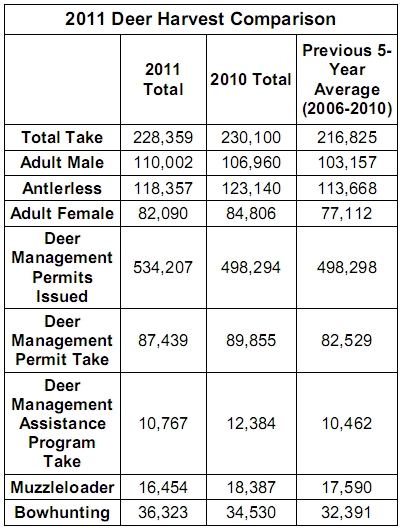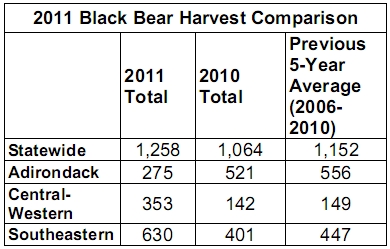Plentiful food and weather conditions favored the bears around here last year.

Entries from March 1st, 2012
275 Harvested Bears
March 1st, 2012 · No Comments · Adirondack Life
Record Bear Harvest and Steady Deer Take in 2011
March 1st, 2012 · No Comments · Adirondack News
 Hunters in New York State harvested more than 228,350 deer and 1,250 bears during the 2011 hunting seasons, New York State Department of Environmental Conservation (DEC) Commissioner Joe Martens announced today. The deer take nearly matched the 2010 deer take while a new record was set for the bear harvest in southern New York.
Hunters in New York State harvested more than 228,350 deer and 1,250 bears during the 2011 hunting seasons, New York State Department of Environmental Conservation (DEC) Commissioner Joe Martens announced today. The deer take nearly matched the 2010 deer take while a new record was set for the bear harvest in southern New York.
“Deer and bear hunting are long-standing traditions in New York, providing a valuable source of food and a means of shared recreation for many families,” Commissioner Martens said. “Throughout the state, hunters play a crucial role by helping to maintain healthy and ecologically sound deer and bear populations.”
Deer Harvest
The 2011 deer take varied less than one percent from the 2010 take statewide. In 2011, hunters took slightly more than 118,350 antlerless deer (adult females and fawns) and just over 110,000 adult male deer (bucks). In the northern zone, the buck take (about 15,900) was essentially unchanged from 2010, though the antlerless harvest (about 10,900) was down about 13 percent from last year. In the southern zone, excluding Long Island, the adult buck take (about 93,100) increased nearly four percent over last year while the antlerless harvest (about 105,400) decreased by three percent.
2011 marked the first year that crossbows were allowed as a legal hunting implement for deer. However, legislation limited crossbow use to the regular firearms seasons and subsequent muzzleloader seasons for deer. Relatively few hunters took crossbows afield and the estimated take by crossbows was only 491 deer statewide, less than 0.25 percent of the total deer harvest.

Throughout the state, hunters took a slightly higher proportion of 2.5-year-old and older bucks than in previous years, continuing a trend that has developed over the past two decades. Throughout most of New York, hunters can take a buck of any age, but an increasing number of hunters are voluntarily choosing to take older bucks with larger antlers. In 2011, 46 percent of harvested bucks were 2.5-years-old or older, compared to only 33 percent in 2000 and 28 percent in the early 1990s.
Western New York and the Finger Lakes Region perennially lead the state in total deer-harvest densities, and deer take in 2011 remained true to form. The top five counties for 2011 were Yates (16.4 total deer per square mile), Wyoming (13.8), Genesee (10.8), Ontario (10.5), and Livingston (10.0).
It’s important to note that the total deer harvest is strongly impacted by the number of Deer Management Permits (DMPs) available in a given area, which govern the harvest of antlerless deer and are used to manage the deer population in a given area.
A more accurate picture of relative deer abundance is revealed by the number of bucks harvested per square mile. The five counties with the most bucks harvested per square mile were: Yates (5.6), Wyoming (5.4), Orange (4.1), Ontario (4.1), and Allegany (4.0). The deer populations in four of the counties listed above (all except Allegany County) are higher than the deer population objectives set for those counties. DEC will continue its efforts to reduce the deer population to achieve the desired density levels wherever necessary.
In 2011, DEC adopted a white-tailed deer management plan (see: New York State Deer Management Plan). The plan will guide DEC deer management and deer hunting decisions for the next five years. In the upcoming weeks, DEC will propose several regulation changes that were identified in the deer management plan. Hunters and the public will have the opportunity to comment on these changes when a formal proposal is made. Some of the proposed revisions include:
- change the start date of the southern zone bow season to October 1;
- establish a youth hunt for deer;
- allow DMPs to be used during the northern zone bow and muzzleloader seasons;
- establish mandatory antler restrictions in seven additional Wildlife Management Units in the Catskills;
- establish a late bowhunting season in portions of the northern zone; and
- establish Deer Management Focus Areas to expand the use of traditional hunting in areas with overabundant deer.
Bear Harvest
Outside of the Adirondack region the 2011 bear harvest set new records, substantially exceeding previous record takes in central and western New York. In contrast, bear take in the Adirondack region dropped to a level not seen since 1998.
Hunters in southeastern New York harvested 630 bears in 2011, besting the previous record of 520 set in 2008. This was due in part to a new rule that expanded bear hunting in eastern New York State to include all or portions of seven new counties in eastern New York from Rockland and Westchester north to Washington beginning in 2011. Hunters took 50 bears from this new area, including 18 bears taken in Washington County, 11 in Rensselaer County, 10 in Columbia County, seven in Dutchess County, two in Putnam County and two in Rockland County. Yet even without these additional bears, take in the rest of the southeastern region exceeded previous record levels, reflecting a 25-year trend of generally increasing bear harvests in this region.
In central and western New York, the 2011 bear take of 353 greatly surpassed the previous record of 193 bears set in 2008. This was due in large part to a regulation change that moved the regular bear season opening day up one week to coincide with the start of the regular deer season. This change was implemented to reduce bear population growth and range expansion. Yet, as with bear take in the southeastern region, it is likely that even without these additional seven days of the regular season in the central-western region, bear take during the traditional season would have matched or exceeded the 2008 record, reflecting a 15-year trend of generally increasing bear harvests in this region.

In the Adirondacks, bear take was below the five-year average during each of the bear seasons and the overall bear take was down about 47 percent from 2010.
Bear harvest rates in the Adirondacks typically drop in the early season during years of abundant soft mast (cherries, raspberries and apples), while the take will increase during the regular season in years with abundant beech nuts.
This past season provided abundant soft mast, particularly raspberries and blackberries in September and October, and bear take during the early season was only 70 bears, about 70 percent below the five-year average. Beech nut abundance was mixed throughout the Adirondacks and the regular season bear take was approximately 15 percent below the five-year average. Additionally, much of the muzzleloading and regular season in the Adirondacks had above average temperatures and snow cover was inconsistent and relatively scarce making bear hunting all the more challenging.
Deer and bear harvest data are gathered from two main sources: harvest reports required by all successful hunters and DEC’s examination of harvested deer and bear at check stations and meat processors. Statewide harvest estimates are made by cross-referencing these two data sources. For more information about the 2011 deer and bear harvests, see DEC’s website at: Deer and Bear Harvests
DEC Region 5 Winter Search and Rescue Report
March 1st, 2012 · No Comments · Adirondack News
 Essex County
Essex County
Town of North Elba, High Peaks Wilderness Area
On Monday, December 26, 2011, at approximately 11:40 pm, DEC Central Dispatch received a call reporting an overdue hiker on or near Mt. Colden. Ronnie Cusmano, 55, of Valhalla, NY, was hiking from the Upper Works Trailhead to Mt. Colden. He routinely used his personal locator device to notify his wife upon completion of his hikes. Mr. Cusmano’s wife had not heard from him and was concerned. A DEC Forest Ranger responded and began searching on the trails south of Mt. Colden. At approximately 3:30am the following morning, the Forest Ranger located Mr. Cusmano in good health at the Herbert Brook Lean-to along the path up Mount Marshall. Always inform someone of your itinerary and stick to it.
Town of Elizabethtown, Hurricane Mountain Wilderness
On Wednesday, December 28, 2011, at approximately 8:52 pm, DEC Dispatch in Ray Brook received a call reporting an overdue hiker on Hurricane Mountain. Clifford Reiter, 54, had started up Hurricane Mountain looking for his two adult sons who were overdue from hiking the mountain. Not aware that his sons had already exited the trail and signed out on the trail register, Mr. Reiter proceeded to search for them. Mr. Reiter’s wife became concerned due to the extreme cold temperatures and called for assistance. Meanwhile, the two sons went back up the trail to search for their father. A DEC Forest Ranger responded and located all three men in good conditions at 9:30 pm. Call DEC Forest Rangers at 518-891-0235 when you believe someone may be lost or injured in the backcountry.
Town of Newcomb, Camp Santanoni Historic Area
On Saturday, January 14, 2012, at approximately 4:00 pm, while on routine state land patrol, a DEC Forest Ranger came upon an injured skier on the Newcomb Lake Road. Barbara Taylor, 58, of Long Lake, NY, had fallen and injured her shoulder and ankle. She was exhausted and needed assistance getting out. The Forest Ranger splinted her injured ankle and evacuated Ms. Taylor by rescue toboggan. At 5:30 pm Ms. Taylor was returned to the trailhead parking areas where she indicated she would seek further medical treatment on her own. Accidents can happen. Always carry a first aid kit and contact the DEC Forest Rangers at 518-891-0235 in backcountry emergencies.
Town of Keene, Giant Mountain Wilderness Area
On Saturday, January 21, 2012, at approximately 1:36 pm, DEC Dispatch in Ray Brook received a call reporting an injured hiker. Ruby Sulley, 58, of Keeseville, NY, was hiking between Hopkins and Giant Mountains, when she fell and suffered a leg injury near the Giant Mountain lean-to at 12:00p.m. Her hiking companions contacted Ray Brook Dispatch and two DEC Forest Rangers responded. Upon reaching Ms. Sulley, they assisted her as she continued to hike out. They reached the trailhead at 5:30 pm where Ms. Sulley indicated she would seek further medical attention on her own. Accidents can happen. Always carry a first aid kit and contact the DEC Forest Rangers at 518-891-0235 in backcountry emergencies.
Town of Keene, Eastern High Peaks Wilderness Area
On Saturday, January 21, 2012, at approximately 2:18 pm, DEC Dispatch in Ray Brook received a call reporting an injured hiker. Kevin Cox, 61, of Troy, NY, was snowshoeing with a group of eight when he twisted his knee near the summit of Lower Wolfjaw. State Police Aviation was unavailable due to potential for blowing snow; and snowmobiles were unable to be used due to lack of snow. Temperatures hovered near zero and below during the rescue. Members of the hiking party had been assisting Mr. Cox by “sliding” him down when he was unable to walk. Seven DEC Forest Rangers responded from the Garden Trailhead in Keene Valley with a rescue sled and met the group at 6:50 pm, approximately 1/4 mile above the Wolfjaw lean-to. Mr. Cox was brought to the Garden parking area at approximately 11:10 pm and the group indicated they would transport Mr. Cox and obtain further medical attention. Dress properly with layers of wool and fleece (NOT COTTON!) clothing: a wool or fleece hat, gloves or mittens, wind/rain resistant outer wear, and winter boots.
Town of North Elba, High Peaks Wilderness Area
On Saturday, February 25, 2012, at approximately 4:50 pm, DEC Dispatch in Ray Brook received a cell phone call from Mike Jones, 42, of Andover, CT, that was transferred from Essex County 911. Mr. Jones reported that he had attempted to hike to the top of Algonquin Mountain on Friday afternoon when he was forced off the trail by high winds and snow. He had bushwhacked down a drainage area and spent the night in hole in the snow. In the morning he continued downhill until he encountered a trail marker and was able to obtain cell phone service. He had no idea where he was and stated he was wet and very cold. Mr. Jones also indicated that he was visiting the area by himself and had not told anyone of his plans to climb Algonquin Mountain, therefore nobody had, or could have, reported him missing.
DEC Dispatch worked with Essex County 911 to obtain Mr. Jone*s cell phone coordinates. It was determined that hes was on the Indian Pass Trail southwest of Rocky Falls approximately 2.5 miles from the trailhead at Adirondack Loj. Three Forest Rangers responded, snowmobiling part of the way down the trail and then skiing the remainder of the way. Deep fresh snow required the Forest Rangers to break trail while on skis. They reached Mr. Jones at 6:42 pm.
Mr. Jones had lost most of his gear and some of his clothing during the night. He appeared to be suffering from hypothermia and frostbite to his hands and feet. After feeding, clothing and warming him, the Forest Rangers helped walk him back to the snowmobile and then transported him by snowmobile to the South Meadow Road. He was transferred to the Lake Placid Rescue Squad at 8:37 pm and transported to Adirondack Medical Center in Lake Placid for further medical evaluation and treatment.
Never travel alone and always inform someone of your intended route and return time. Check weather before entering the woods – if the weather is poor, postpone your trip. Be aware of weather conditions at all times – if the weather worsens, head out of the woods. Be prepared to spend an unexpected night in the woods pack plenty of food and water, extra clothing, flashlight/headlamp, ensolite pads, stove and extra fuel, and bivy sack or space blanket.
Town of North Elba, High Peaks Wilderness Area
On Saturday, February 25, 2012, at approximately 7:30 pm, DEC Dispatch in Ray Brook received a call from the wife of Brian Sullivan, 62, of Brooklyn,NY, reporting him overdue. Mr. Sullivan had left from The Garden trailhead at 10:30 am and planned to ski to the Mt. VanHovenburg Ski Center at the Olympic Sports Complex via Johns Brook, the Klondike Notch Trail and the Mr. Van Trail.Staff from the ski center patrolled the nearby portions of the Mr. Van Trail but had not seen Mr. Sullivan.
Seven DEC Forest Rangers responded and began searching from the two ends of Mr. Sullivan’s planned route. A Forest Ranger on a snowmobile on the South Meadow Road heard shouting shortly before 9 pm. He stopped, turned off the snowmobile and took off his helmet allowing him to clearly hear Mr. Sullivan*s shouts from the other side of South Meadow Brook. The Forest Ranger directed Mr. Sullivan across the brook, met up with him and found that he was in good condition. He was transported by snowmobile to the Adirondack Loj and reunited with his family at 9:30 pm. Know your route, the terrain and your physical capabilities – remember it takes more time and energy to travel through snow than it does on bare ground. Check the DEC Adirondack Trail Information webpage at http://www.dec.ny.gov/outdoor/7865.html for information on the latest conditions, weather and trail closures and reroutes.
Town of Keene, High Peaks Wilderness Area
On Saturday, February 25, 2012, at approximately 11:38 pm, DEC Central Dispatch received a call from the girlfriend of Matthew Bradley, 36, of Lee, MA, reporting him overdue. He had left from the Garden Trailhead on Saturday, planning to snowshoe to the summit of Mt. Marcy via Johns Brook and either the Phelps Trail or the Hopkins Trail. He then planned to continue to Adirondack Loj Trailhead via the VanHovenberg Trail.
Eleven Forest Rangers, including three Forest Rangers who had participated in the previous two searches, responded and searched through the night. DEC Central Dispatch had very limited and sporadic cell phone contact with Mr. Bradley because his cell phone battery was dying. Dispatchers were unable to get location information from him or obtain the coordinates of his cell phone. At 5 am Mr. Bradley was able to place a quick call from his cell phone and provide the coordinates from his GPS. Forest Rangers determined that he was off trail in a drainage area on the southwestern slopes of Table Top Mountain.
Forest Rangers reached Mr. Bradley at approximately 9:20 am. He had moderate hypothermia and possible frostbite. Forest Rangers provided him food and then escorted him to an open area for retrieval. Mr. Bradley was hoisted into a State Police Aviation Unit helicopter with a Forest Ranger operating the hoist and transported to the Adirondack Medical Center in Saranac Lake for further medical evaluation and treatment. Know your route, the terrain and your physical capabilities – remember it takes more time and energy to travel through snow than it does on bare ground. Be prepared to spend an unexpected night in the woods pack plenty of food and water, extra clothing, flashlight/headlamp, ensolite pads, stove and extra fuel, and bivy sack or space blanket.
Franklin County
Town of Brighton, Private Land
On Friday, January 6, 2012, at approximately 3:40 pm, DEC Dispatch in Ray Brook received a call from Franklin County 911 reporting two skiers lost on the trails at the Paul Smith’s College Visitor Interpretive Center (VIC). James Mort, 61 and Patricia Mort, 57, both of Red Hook, NY, had skied off the main trail system and were at a gazebo on the far side of a secondary trail system. They declined the option of following their tracks back to the main trail or out to the road and back to the VIC, due to exhaustion and lack of lights. One DEC Forest Ranger responded and located the couple. They were escorted out to the road and transported back to the VIC. Know your route, the terrain and your physical capabilities. Always carry a light, a map and a compass.
Hamilton County
Town of Lake Pleasant, Jessup River Wild Forest
On Saturday, February 11, 2012, at approximately 2:00 pm, a DEC Forest Ranger was notified of an injured snowmobiler on the Perkins Clearing Easement Trail. Dave Gervald, 32, of Wayne, NJ, was traveling too fast for conditions, when he struck a tree and was ejected from his machine. He suffered severe leg lacerations and also complained of back pain. Two DEC Forest Rangers and two DEC Environmental Conservation Officers responded along with Speculator Rescue, Hamilton County Sheriff, and New York State Police. Mr. Gervald was backboarded, packaged and transported by snowmobile 6 miles to the waiting ambulance. He was then transported to Mason-Latour Hospital in Gloversville for medical treatment. Know your abilities and travel at reasonable speeds when driving snowmobiles. Always carry a first aid kit and contact the DEC Forest Rangers at 518-891-0235 in emergencies.
Town of Indian Lake, Blue Mountain Wild Forest
On Saturday, February 18, 2012, Lars Jackson, 45, of Pelham Manor, NY, had hiked with a group of Boy Scouts to the top of Blue Mountain in the Town of Indian Lake Hamilton County when he went into cardiac arrest. Hamilton County 911 contacted DEC Dispatch in Ray Brook at 1:40 pm to report the situation. They indicated that cardio-pulmonary resuscitation (CPR) was being administered by members of Mr. Lars group.
DEC Forest Rangers, Blue Mountain Lake Rescue, Indian Lake Rescue, and Indian Lake Fire & Rescue responded to the incident. A DEC Forest Ranger arrived at 2:20 pm to observe that CPR had been continuing for approximately 1 hour. CPR continued while an automated external defibrillator was applied to no avail. CPR was discontinued at 2:27 pm. The State Police and the Hamilton County Coroner’s Office were notified. Mr. Jackson was pronounced dead by the coroner. Contact the DEC Forest Rangers at 518-891-0235 in backcountry emergencies.
Town of Indian Lake, Blue Ridge Wilderness Area
On Sunday, February 26, 2012, at approximately 3:36 pm, DEC Dispatch in Ray Brook received a call from the Hamilton County Sheriff’s office, reporting lost hikers on the Cedar River Loop trail system. Irwin Nathonson, 64, and Julie Nathonson, 62, both of Diamond Point, NY, had not crossed the Cedar River Road and became lost. Three DEC Forest Rangers responded and each began searching on a different section of the trail system. At 4:53 pm the Mr. and Mrs. Nathonson were located in good health. They were transported out on snowmobiles and returned to their vehicle. Carry a map and compass and know how to use them.
Tags: accident·dec·essex county·franklin county·hamilton county






